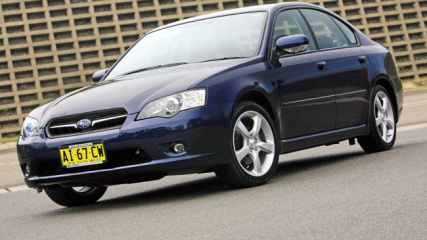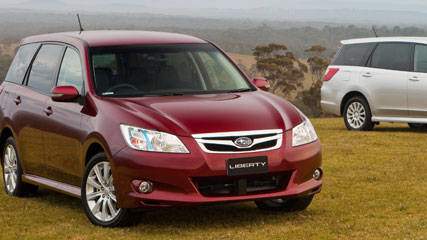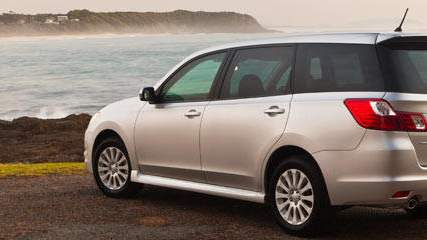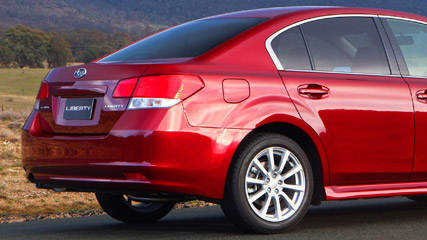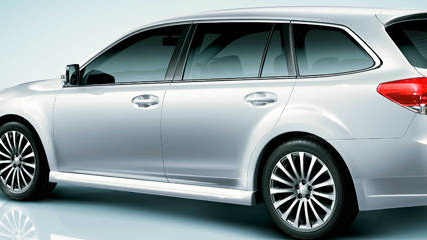Subaru Liberty and Outback 2009 Review
By Neil McDonald · 11 Sep 2009
Rival car companies covet the brand loyalty that Subaru has among its followers. When it comes to trade-in time, more than 70 per cent of owners stick with the Japanese brand. With this carpark of committed Subaru owners in mind, that the company has taken on-board customer feedback about how to make the latest-generation Liberty and Outback better.Bigger, safer and more economical Both all-wheel drive models have grown slightly in all dimensions with the 80mm longer wheelbase in the sedan and 75mm longer in the Outback contributing to more rear seat leg and headroom and luggage space. Despite being between 17kg and 94kg heavier than the old model, new engines are more economical than those they replace and kinder to the planet.Safety has also improved, with a new engine ‘cradle’ to not only help the car crumple better in an impact, but reduce noise and vibration.New technology, like a continuously variable transmission on 2.5i models and new six-speed manual transmission feature. Subaru has also dumped the Liberty GT wagon but added a new model, the 2.5i Sport. Subaru Australia managing director, Nick Senior, says the company also looked for greater styling differentiation between the Liberty and Outback too. "They look more distinct now," he says.Drivetrains Two new engines are available, a 2.5i four-cylinder and 3.6-litre six-cylinder, which replaces the 3.0-litre. A 2.0-litre turbo diesel arrives in the Outback in November. The 2.5i four-cylinder ‘boxer’ engine and CVT, which is expected to account for about 75 per cent of sales, has a combined fuel economy figure of 8.4 litres per 100km, compared to 9.5 for the old car. The 2.5i develops less power but more torque across the rev range than the old engine with 123kW at 5600 revs and 229Nm at 4000 revs on tap.The new 3.6-litre is the largest engine ever fitted to the Liberty range. The entry 2.5i and 2.5i Sports models get what Subaru calls its Lineartronic CVT. Also new on entry-level the 2.5i is a six-speed manual, shared with the turbocharged Liberty GT.All automatics, including Lineartronic CVT, have a sequential mode to suit driving style and road conditions as well as steering wheel mounted paddle shifters. The turbo GT and 3.6R get an improved five-speed automatic. Prices for some models have decrease by up to 7.8 per cent while others cost the same as the superseded variants.Variants and pricing Entry-level Liberty 2.5i starts from $33,990, with the CVT auto adding $2500 to the price. The range-topping Liberty GT Premium is $52,990, $4500 less than the superseded GT spec.B, while the new Liberty 3.6R Premium is the same price as the superseded Liberty 3.0R Premium.Appearance and equipment Visually, the car has a more upright look with a flowing headlight design that sweeps high up the mudguards. Apart from the gains in cabin room, access to the rear seats is easier via larger opening doors. Standard equipment includes seven airbags - including driver's knee airbag - electronic stability control, dual zone air conditioning, hill start assist, trip computer, cruise control, six-stacker in-dash CD stereo and 17-inch alloys on the 2.5i.The 2.5i Premium adds sunroof, leather, CVT automatic, electric driver's seat and rear air vents. The 2.5i Sports opens the standard package with the Lineartronic CVT , 18-inch alloys, Bilstein suspension, sports grille and bumper, alloy pedals and Xenon headlights with washers. Premium models add automatic headlights and wipers, McIntosh stereo systems, reversing camera, SI-Drive, satellite navigation, keyless access and push-button start.The McPherson strut-type front suspension is now mounted to the cradle to improve steering response, handling and overall rigidity. The rear suspension is a compact double-wishbone rear suspension, shared with the Forester. The Liberty has followed the new-generation Forester with framed windows, which add to structural strength of the doors. Using an electric parking brake instead of a traditional lever has freed up more space between the front seats.DrivingThe gods did not shine kindly on the Liberty drive. The heavens opened up with lashing rain and blustery winds, leading to muddy and slippery country roads. But inside the Liberty sedan, all was serene. Subaru's relish being let lose in such conditions and the Liberty proved it has ability and confidence in spades. All-wheel drive is almost second nature and when you throw electronic stability control and traction control into the mix the Liberty is the perfect wet weather partner.We spent most of the time behind the wheel of the 2.5i CVT automatic, which is expected to account for the bulk of sales. What is immediately noticeable is how much room the car has, both in the front and rear seats. The front seats have also been redesigned and are more comfortable and supportive. Only the low-rent look of the seat fabric in the 2.5i let the interior down.There are some neat touches, like the levers to fold down the rear seats in the wagon, reversing camera on satellite navigation equipped models and the paddle shifters on the steering wheel. Yes, other brands have them but the Liberty is more than a match for equipment up against key rivals like the Mazda6, Toyota Camry and Honda Accord. The 2.5-litre four is quiet — almost too quiet for those Subaru fans who love the throb of the boxer layout — and the steering has plenty of feedback and feel.Developing 123kW, the new engine has lost 4kW but torque is up 2Nm to 229Nm and it is delivered lower in the rev range. This translates into more linear acceleration. There is little to fault about the dynamics or engineering. The Liberty is a very secure car to punt both on bitumen and gravel roads. The ride is composed and the multi-link double wishbone rear suspension provides the car with a surefooted stance over corrugated roads.The CVT, which has some links with Audi, is new and like these seamless transmissions, is smooth and can be used as a sequential six-speed - with paddle shifters - if you want. Fortunately Subaru has also managed to inject some conventional auto feel into the CVT via some trick software and there is no hint of the "slipping clutch" feeling of some CVTs.Cabin quality is as good as the best out of Japan despite some hard plastics around the cabin. The faux woodwork on the upper models is clearly meant for more conservative North American tastes. Despite the styling and interior presentation catering more to its biggest export market, North America, the grown up Liberty has lost little of its inherent Subaru-ness. And that should please Liberty owners who would not drive anything else.Subaru Liberty sedan and wagon Price: from $33,990 (2.5i manual) to $51,990 (3.6R Premium)Power: 123kW at 5600 revs (2.5i), 195kW at 5600 revs (2.5 GT), 191kW at 5600 revs (3.6R)Torque: 229Nm at 4000 revs (2.5i), 350Nm at 2400 revs (2.5 GT), 350Nm at 4400 revs (3.6R)Transmission: Six speed manual, five speed automatic and CVT automatic Economy: 2.5i manual is 8.9 litres/100km (combined), 2.5i CVT 8.4 litres/100km (combined), 2.5i GT manual 9.8 litres/100km (combined), 2.5i GT auto 9.7 litres/100km (combined), 3.6 R auto 10.3 litres/100km (combined).Emissions CO2: 209 g/km (2.5i), 198 g/km (2.5i auto), 230 g/km, (GT man), 228 g/km (GT auto), 242 g/km (3.6R)

